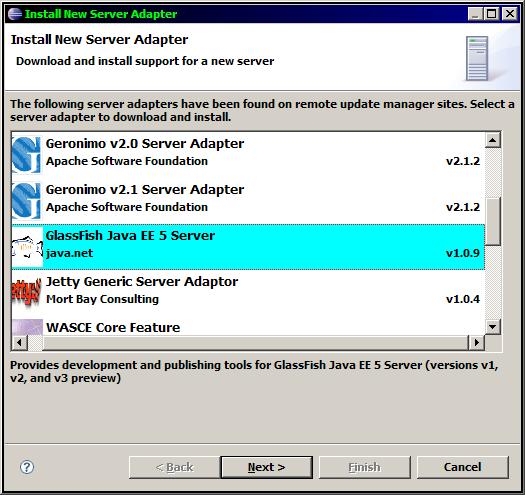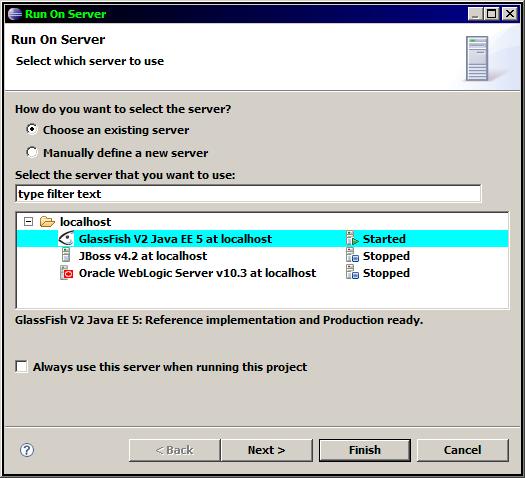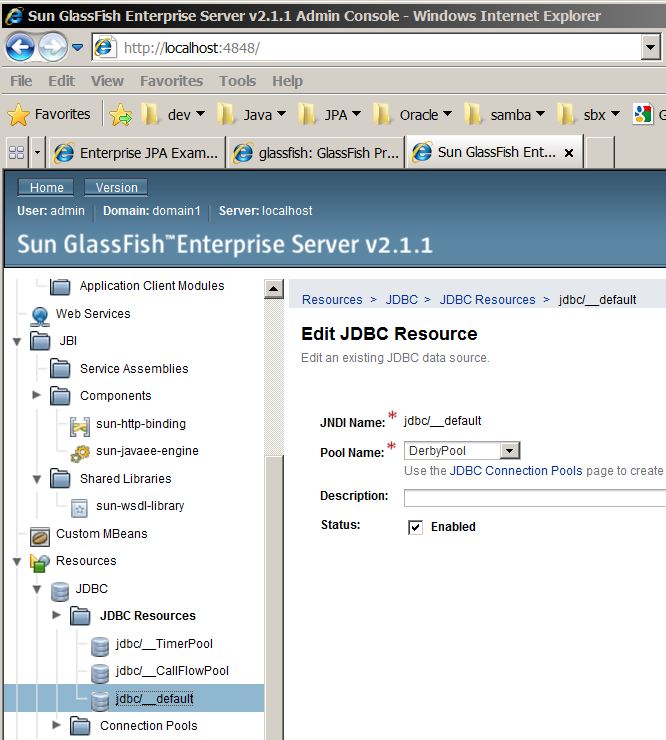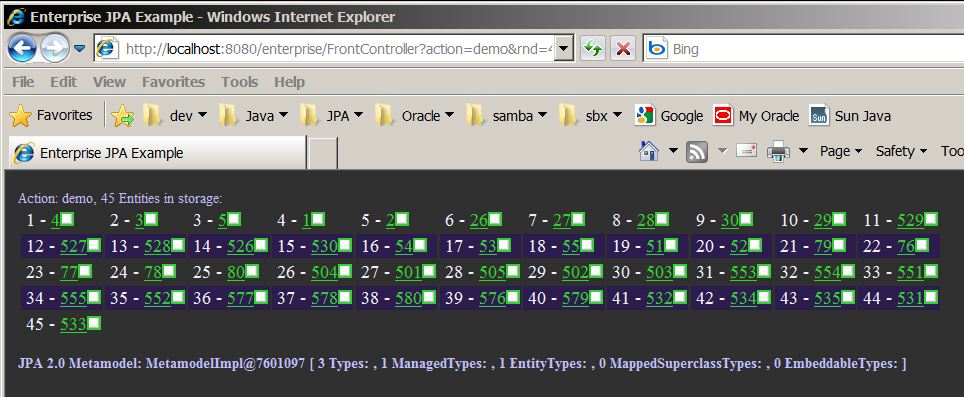Notice: this Wiki will be going read only early in 2024 and edits will no longer be possible. Please see: https://gitlab.eclipse.org/eclipsefdn/helpdesk/-/wikis/Wiki-shutdown-plan for the plan.
Difference between revisions of "EclipseLink/Examples/JPA/GlassFishV2 Web Tutorial"
m (→EclipseLink JPA Deployed on GlassFish 2.1 using Eclipse WTP) |
m (→EclipseLink JPA Deployed on GlassFish 2.1 using Eclipse WTP) |
||
| Line 10: | Line 10: | ||
The [http://wiki.eclipse.org/Dali DALI] project was used to generate Entities from a schema with sequences already populated. | The [http://wiki.eclipse.org/Dali DALI] project was used to generate Entities from a schema with sequences already populated. | ||
| − | The details described here are valid for both GlassFish V2 and the SUN Java System Application Server 9 | + | The details described here are valid for both GlassFish V2 2.1.1 and the SUN Java System Application Server 9 |
==Development Environment== | ==Development Environment== | ||
| − | '''Software:''' [http://www.eclipse.org/downloads/download.php?file=/technology/epp/downloads/release/ganymede/R/eclipse-jee-ganymede-win32.zip Eclipse IDE for Java EE 3.4 Ganymede] (June 2008 +) with all 5 packages (DTP 1.6, EMF 2.4, GEF 3.4, WTP 3.0, XSD 2.4), [http://db.apache.org/derby Derby Database 10.4], Java JDK 1.6.0_04, [https://glassfish.dev.java.net/downloads/v2.1- | + | '''Software:''' [http://www.eclipse.org/downloads/download.php?file=/technology/epp/downloads/release/ganymede/R/eclipse-jee-ganymede-win32.zip Eclipse IDE for Java EE 3.4 Ganymede] (June 2008 +) with all 5 packages (DTP 1.6, EMF 2.4, GEF 3.4, WTP 3.0, XSD 2.4), [http://db.apache.org/derby Derby Database 10.4], Java JDK 1.6.0_04, [https://glassfish.dev.java.net/downloads/v2.1.1-final.html GlassFish V2.1.1] |
This example will run fine with any Database that EclipseLink supports. | This example will run fine with any Database that EclipseLink supports. | ||
| Line 19: | Line 19: | ||
==Prerequisites== | ==Prerequisites== | ||
===<font color="green">Install Eclipse EE</font>=== | ===<font color="green">Install Eclipse EE</font>=== | ||
| − | *I installed a clean version of Eclipse | + | *I installed a clean version of Eclipse 3.5 32-bit EE edition. |
| − | + | ||
===<font color="green">Install a Database</font>=== | ===<font color="green">Install a Database</font>=== | ||
| − | *In this example I am using [http://db.apache.org/derby Derby 10. | + | *In this example I am using [http://db.apache.org/derby Derby 10.5.3.0], the table schemas have already been created by the following Java SE project in SVN - http://dev.eclipse.org/svnroot/rt/org.eclipse.persistence/trunk/examples/org.eclipse.persistence.example.jpa.server.common.ddlgen/ |
*GlassFish comes preconfigured with a JNDI datasource connection to Derby. | *GlassFish comes preconfigured with a JNDI datasource connection to Derby. | ||
===<font color="green">Install GlassFish</font>=== | ===<font color="green">Install GlassFish</font>=== | ||
| − | I installed the latest [https://glassfish.dev.java.net/downloads/v2.1- | + | I installed the latest [https://glassfish.dev.java.net/downloads/v2.1.1-final.html GlassFish V2.1.1 Final build] and followed the instructions on that page. |
| − | * C:\opt>java -Xmx256m -jar glassfish-installer-v2.1- | + | * C:\opt>java -Xmx256m -jar glassfish-installer-v2.1.1-b31g-windows.jar |
* C:\opt\glassfish>cd glassfish | * C:\opt\glassfish>cd glassfish | ||
* C:\opt\glassfish>ant -f setup.xml | * C:\opt\glassfish>ant -f setup.xml | ||
| − | ===Install GlassFish Eclipse 3. | + | ===Install GlassFish Eclipse 3.5 Server Plugin=== |
| − | The GlassFish server plugin is not shipped by default with Eclipse - you will need to update your Eclipse IDE to pick up the plugin. | + | *The GlassFish server plugin is not shipped by default with Eclipse - you will need to update your Eclipse IDE to pick up the plugin. |
| − | + | **Goto the Servers tab in a Java EE view and right-click New | Server | |
| − | *Goto the Servers tab in a Java EE view and right-click New | Server | + | **Select the link "Download additional Server adapters" |
| − | *Select the link "Download additional Server adapters" | + | **Select the GlassFish Java EE 5 Server from java.net - make sure it is version 1.0.9+ |
| − | *Select the GlassFish Java EE 5 Server from java.net - make sure it is version 1.0.9+ | + | |
[[Image:Glassfish_download_additional_servers.JPG]] | [[Image:Glassfish_download_additional_servers.JPG]] | ||
| Line 195: | Line 193: | ||
===Browser Output=== | ===Browser Output=== | ||
[[Image:Glassfish_ear_application_screen.JPG]] | [[Image:Glassfish_ear_application_screen.JPG]] | ||
| − | |||
| − | |||
| Line 204: | Line 200: | ||
==References== | ==References== | ||
*See [[EclipseLink/UserGuide/Developing_JPA_Projects_%28ELUG%29|Developing JPA Projects]] in the EclipseLink User's Guide. | *See [[EclipseLink/UserGuide/Developing_JPA_Projects_%28ELUG%29|Developing JPA Projects]] in the EclipseLink User's Guide. | ||
| − | + | ==Timeline== | |
| − | Originated on build 20080915 - Michael O'Brien | + | *20080915 - Originated on build 20080915 - Michael O'Brien |
| + | *20091207 - retrofitting for JPA 2.0 usage | ||
Revision as of 17:27, 7 December 2009
Contents
- 1 EclipseLink JPA Deployed on GlassFish 2.1 using Eclipse WTP
- 1.1 Development Environment
- 1.2 Prerequisites
- 1.3 GlassFish Configuration Changes
- 1.4 JNDI Datasource Setup
- 1.5 Persistence JAR location
- 1.6 EclipseLink JAR location
- 1.7 Downloading EclipseLink Libraries
- 1.8 JDBC JAR location
- 1.9 Create J2EE application
- 1.10 JPA Entity Configuration
- 1.11 Persistence.xml
- 1.12 Start Server
- 1.13 Publish EAR
- 1.14 Perform CRUD operations: JPQL insert and query
- 1.15 References
- 1.16 Timeline
EclipseLink JPA Deployed on GlassFish 2.1 using Eclipse WTP
Note: This tutorial' is under construction for the next week as of 20080915.
If you want to get a small web application running quickly on GlassFish - the services provided by the Web Tools Project plugin in the Eclipse IDE can take care of the deployment details and set the server into debug mode for you.
This basic example details how to use Eclipse to run/debug a minimum J2EE web application servlet using EclipseLink JPA as the persistence provider. The goal of this example is to detail the minimum steps needed to run EclipseLink inside SUN GlassFish using the Eclipse IDE - at this point no presentation/controller layer such as JSF, Spring or Struts will be used beyond a basic HttpServlet so we can concentrate on the the integration layer JPA setup.
The DALI project was used to generate Entities from a schema with sequences already populated.
The details described here are valid for both GlassFish V2 2.1.1 and the SUN Java System Application Server 9
Development Environment
Software: Eclipse IDE for Java EE 3.4 Ganymede (June 2008 +) with all 5 packages (DTP 1.6, EMF 2.4, GEF 3.4, WTP 3.0, XSD 2.4), Derby Database 10.4, Java JDK 1.6.0_04, GlassFish V2.1.1
This example will run fine with any Database that EclipseLink supports.
Prerequisites
Install Eclipse EE
- I installed a clean version of Eclipse 3.5 32-bit EE edition.
Install a Database
- In this example I am using Derby 10.5.3.0, the table schemas have already been created by the following Java SE project in SVN - http://dev.eclipse.org/svnroot/rt/org.eclipse.persistence/trunk/examples/org.eclipse.persistence.example.jpa.server.common.ddlgen/
- GlassFish comes preconfigured with a JNDI datasource connection to Derby.
Install GlassFish
I installed the latest GlassFish V2.1.1 Final build and followed the instructions on that page.
- C:\opt>java -Xmx256m -jar glassfish-installer-v2.1.1-b31g-windows.jar
- C:\opt\glassfish>cd glassfish
- C:\opt\glassfish>ant -f setup.xml
Install GlassFish Eclipse 3.5 Server Plugin
- The GlassFish server plugin is not shipped by default with Eclipse - you will need to update your Eclipse IDE to pick up the plugin.
- Goto the Servers tab in a Java EE view and right-click New | Server
- Select the link "Download additional Server adapters"
- Select the GlassFish Java EE 5 Server from java.net - make sure it is version 1.0.9+
Validating the GlassFish/Eclipse configuration
- Use the V2 plugin when creating a server
- Start the server to test the plugin
- You should see the following message when running http://127.0.0.1:8080
Sun Java System Application Server 9.1.1 (build b50-fcs)
- Create an empty EAR application using the Eclipse JEE application wizard
- Create an EJB and Web subproject - do not add any facets for other servers - as GlassFish does not appear in the "Target Runtime" dropodown yet
- Switch the EAR version to 5.0 from 1.4
- Add a test.jsp page to the Web project
- Create an EJB and Web subproject - do not add any facets for other servers - as GlassFish does not appear in the "Target Runtime" dropodown yet
- Select the EAR project, right-click and "Run on Server"
- You should see an empty jsp page when running http://127.0.0.1:8080/glassFishTestWeb/test.jsp
GlassFish Configuration Changes
The following configuration changes will need to be done within the GlassFish [http:/127.0.0.1"4848 admin] console.
JNDI Datasource Setup
Global Scoped Datasource Setup
After logging into the admin console navigate to the following 2 sections to setup the JDBC connection pool and DataSource.
Setup GlassFish JDBC Connection Pool
- 1 - create your own connection pool and datasource
Resource | JDBC | Connection Pools | New Connection Pool Resource | JDBC | Connection Pools | New JDBC DataSource
- 2 - or use the preconfigured datasource "jdbc/__default" that comes with GlassFish
- You may want to remove the property ;create=true to manage your own database state.
- You should see the following logs on predeploy
[EL Config]: 2008.09.15 15:20:52.611--ServerSession(20983130)--Connection(4519815)--Thread(Thread[main,5,main])--connecting(DatabaseLogin( platform=>DerbyPlatform user name=> "APP" datasource URL=> "jdbc:derby:C:/opt/derby104/sun-appserv-samples;create=true" )) [EL Config]: 2008.09.15 15:20:54.200--ServerSession(20983130)--Connection(22611277)--Thread(Thread[main,5,main])--Connected: jdbc:derby:C:/opt/derby104/sun-appserv-samples User: APP Database: Apache Derby Version: 10.3.2.1 - (599110) Driver: Apache Derby Embedded JDBC Driver Version: 10.3.2.1 - (599110)
Persistence JAR location
- You will not need to add a jar for the Persistence API 1.0 - GlassFish already includes it.
- However, your project will need a reference to $EclipseLink\plugins\javax.persistence_*.jar
EclipseLink JAR location
- GlassFish V2 Build 32+ is aware of EclipseLink - however you still need to copy the latest eclipselink.jar into GlassFish.
- The eclipselink.jar should be placed off of the container lib directory $GLASSFISH_HOME/lib
- It is not recommended that the EAR include its own version of eclipselink.jar.
- Your eclipse project should reference but not include this jar.
Downloading EclipseLink Libraries
Download EclipseLink using HTTP - recommended
- Proceed to the following URL and download the latest eclipselink.zip which contains everything you need.
- http://www.eclipse.org/eclipselink/downloads/index.php
- Click on the "EclipseLink Installer Zip link which resolves to http://www.eclipse.org/downloads/download.php?file=/rt/eclipselink/releases/n.n.n/eclipselink-n.n.n.zip
- http://www.eclipse.org/eclipselink/downloads/index.php
- Expand the zip file and get the following 2 files
- eclipselink-*\eclipselink\jlib\eclipselink.jar
- eclipselink-*\eclipselink\jlib\jpa\javax.persistence_*.jar
Download EclipseLink using Maven
See the repository on http://www.eclipse.org/eclipselink/downloads/index.php
Download EclipseLink using SVN - developers only
- Get the following eclipselink.jar and javax.persistence*.jar from http://www.eclipselink.org ready for your EclipseLink shared library.
- The following page details four different ways to either obtain the binary jars or download the source and build them yourself with an anon account.
- http://wiki.eclipse.org/EclipseLink/Source
JDBC JAR location
Jars for Derby 10, Oracle 11, MySQL 5 and Sybase 5.5/6.0 should be placed off the container lib directory $GLASSFISH_HOME/lib if they don't already exist.
Create J2EE application
Create your own J2EE Enterprise Application as below. File | new | project | J2EE | Enterprise Application Project Select server, use 5.0 Ear version
Create a new Web and an optional EJB project
Select generate deployment descriptor if you want to change the context-root
- Path changes
<classpathentry combineaccessrules="false" kind="src" path="/org.eclipse.persistence.core"/> <classpathentry combineaccessrules="false" kind="src" path="/org.eclipse.persistence.jpa"/> or <classpathentry combineaccessrules="false" kind="src" path="/eclipselink.jar"/>
- After EAR project creation - reference the org.eclipse.peristence.core and jpa projects or include a reference to eclipselink.jar in your WAR project.
- If you don't reference the eclipselink.* projects then include a classpath reference to persistence.jar and an Oracle (or other Database) JDBC driver jar for your DB.
JPA Entity Configuration
For all other application servers that support JPA 1.0 profiled so far (WebLogic, OC4J, Tomcat and JBoss) - I was able to use BigDecimal as the @Id for entity classes. In GlassFish 2 I had to switch to using BigInteger (or Long) as the entity @Id.
@Entity @Table(name="STAT_LABEL") public class StatLabel implements Serializable { @Id // keep the sequence column name under 30 chars to avoid an ORA-00972 @SequenceGenerator(name="STAT_SEQUENCE_LABEL", sequenceName="STAT_LABEL_SEQ", allocationSize=25) @GeneratedValue(generator="STAT_SEQUENCE_LABEL") private BigInteger id; ....
Persistence.xml
The GlassFish V2 server is defined as the SUN Application Server 9 in JPA as "SunAS9"
Verify in particular that you have the eclipselink.target-server property set - especially if you are migrating from TopLink Essentials to EclipseLink - where the provider and target-server were defaulted.
- JTA : Put persistence.xml beside your JPA entities in yourProjectEJB/ejbModule/META-INF
<persistence version="1.0" xmlns="http://java.sun.com/xml/ns/persistence" xmlns:xsi="http://www.w3.org/2001/XMLSchema-instance" xsi:schemaLocation="http://java.sun.com/xml/ns/persistence http://java.sun.com/xml/ns/persistence/persistence_1_0.xsd"> <persistence-unit name="unified" transaction-type="JTA"> <provider>org.eclipse.persistence.jpa.PersistenceProvider</provider> <jta-data-source>jdbc/__default</jta-data-source> <properties> <property name="eclipselink.target-server" value="SunAS9"/> <property name="eclipselink.logging.level" value="FINEST"/> <property name="eclipselink.session-name" value="eclipselinkwls"/> </properties> </persistence-unit> </persistence>
- RESOURCE_LOCAL : non-JTA : Put persistence.xml beside your JPA entities in yourProjectEJB/ejbModule/META-INF
- This one is used by a local SE Java app to create and pre-populated the derby database
<persistence-unit name="stat.create.tables" transaction-type="RESOURCE_LOCAL"> <provider>org.eclipse.persistence.jpa.PersistenceProvider</provider> <class>entity..</class> <properties> <property name="eclipselink.jdbc.platform" value="org.eclipse.persistence.platform.database.DerbyPlatform"/> <property name="eclipselink.jdbc.driver" value="org.apache.derby.jdbc.EmbeddedDriver"/> <property name="eclipselink.target-database" value="Derby"/> <property name="eclipselink.jdbc.url" value="jdbc:derby:C:/opt/derby104/sun-appserv-samples;create=true"/> <property name="eclipselink.jdbc.user" value="APP"/> <property name="eclipselink.jdbc.password" value="APP"/> <property name="eclipselink.logging.level" value="FINEST"/> <property name="eclipselink.ddl-generation" value="drop-and-create-tables"/> <property name="eclipselink.ddl-generation.output-mode" value="database"/> </properties> </persistence-unit>
Start Server
- Steps: Select the EAR and [Run on Server].
- The first "Run on Server" may not start the server, in this case you "Start Server" and then "Run on Server".
Publish EAR
Perform CRUD operations: JPQL insert and query
Browser Output
All of persistence.xml configuration, jpql query example - in progress ......
References
- See Developing JPA Projects in the EclipseLink User's Guide.
Timeline
- 20080915 - Originated on build 20080915 - Michael O'Brien
- 20091207 - retrofitting for JPA 2.0 usage




